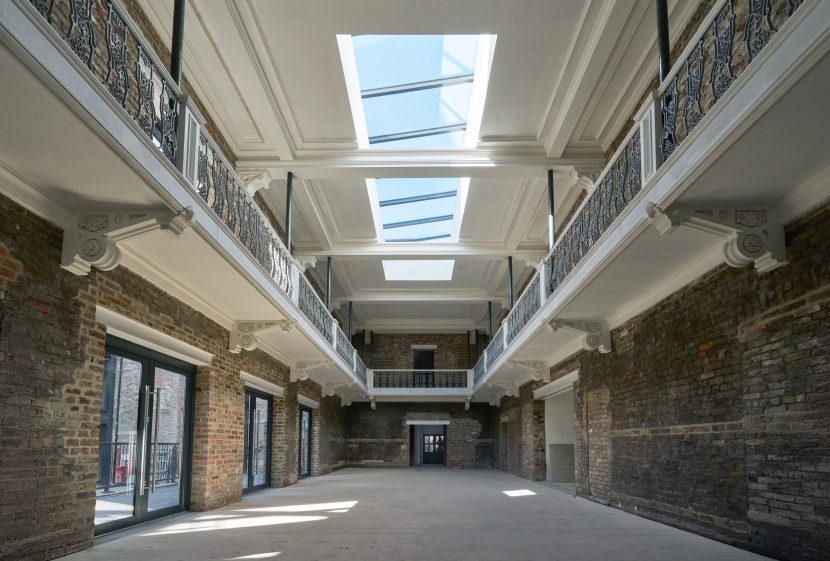Ryder Architecture, in conjunction with the project team comprising of Avison Young, SHED Engineers, OOBE Landscape Architects, and contractor Bowmer + Kirkland, has successfully completed the historic restoration and extension of Newcastle’s Grade II listed Worswick Chambers and 93-101 Pilgrim Street. The multi-million-pound project will now be transformed through tenant fitout into a contemporary leisure space, preserving the building’s rich history. Alongside neighbouring Bank House, the regeneration project will inject new life into this part of Pilgrim Street.
Pilgrim Street, historically a crucial north-south route through Newcastle, was originally lined with burgage plots on both sides. These medieval land divisions are still evident today in the remaining former townhouses, notably 93-101 Pilgrim Street, which were constructed in the 18th century. Adjacent to these, Worswick Chambers, built in the late 19th century, served as an auction hall and offices. The term chambers refers to a collection of small rooms, but the building is distinguished by its central, double-height space with an ornate viewing balcony—an unusual feature that has become the focal point for the site’s redevelopment.
The original routes through the burgage plots have been preserved, providing access to the courtyard and surrounding Pilgrim Place. These historical pathways are also referenced in the design of the new cladding on the contemporary extension. The cladding, composed of solid panels and varying gauges of mesh, subtly nods to the former narrow strips created by the burgage plots.
Restoring the buildings was not without its challenges and required meticulous attention to detail by the project team. Works included asbestos removal, structural stabilisation, the complete replacement of floors and roofs, detailed restoration of facades, damp treatment to bring basements back into use, and the refurbishment of historic windows, staircases and cornices.
Ryder’s commitment to conserving the buildings’ unique heritage is showcased through the bespoke design of shop fronts, which have been developed in close collaboration with a joinery specialist and Newcastle City Council planning and heritage officers. The grand auction hall balcony and staircases, a key feature of the building, have undergone precise removal and reconstruction using digital scans to recreate missing intricate metalwork.
A modern extension contrasts and complements the historic building, incorporating steel framing, shipping containers, and aluminium cladding, creating open air terraces. The contemporary addition sits in harmony with the existing architecture while making way for new functionalities, including a new courtyard which will host music and entertainment.
Associate and Project Architect at Ryder, Alex Blaylock, said:
“Completing the project required passion and commitment from the design and construction team. The nature of the project meant we started with many unknowns, and the building’s condition was far worse than it initially appeared. Despite these challenges, the scheme has been transformational for Pilgrim Street. We’re proud to see Worswick Chambers beautifully and sensitively restored, and now standing as a landmark that can be enjoyed by the entire city for many years to come.”
The Worswick Chambers restoration is part of the wider extensive Pilgrim Street regeneration, which includes the recently completed Bank House office building, the ongoing Pilgrim’s Quarter development, which will be home to over 9,000 HMRC employees, and the boutique fire station hotel, all designed by Ryder.
Ian Crow, Partner and Project Director at Ryder, commented:
“Worswick Chambers not only preserves an important piece of Newcastle’s architectural history but also forms a critical part of a broader masterplan, breathing new life into the city centre, creating jobs and adding to the city’s flourishing streetscape. One of the project’s greatest successes has been re establishing Pilgrim Street’s strong connection between place and people whilst retaining its distinct heritage.”
Roger Thornton, Head of Property at Motcomb Estates, added:
“Ryder has been passionate about this project from the outset, proactively addressing the kind of day to day challenges that arise on a complex restoration.
“The team at Ryder showed experience and good judgement in balancing the masterplan vision, the ambitious tenant requirements and the detailed heritage and conservation needs of the local authority. The building is a credit to the project team and will bring diversity and new life to the wider Pilgrim Street development.”
Neil Mandle, Project Manager and Director at Avison Young, stated that:
“From a technical perspective this was a very challenging project, balancing the design and conservation demands of a listed building while integrating a modern extension and materials alongside the traditional forms of construction. The project team worked very hard and in a collaborative way to deliver a successful outcome and preserve the longer term future of this important property.”
The final stage of the repurposed Worswick Chambers is set to commence this month, with the new leisure complex planned to open its doors in spring 2025.
The project is the result of a collaborative effort between Ryder, Avison Young, SHED Engineers, OOBE Landscape Architects, and contractor Bowmer + Kirkland.

